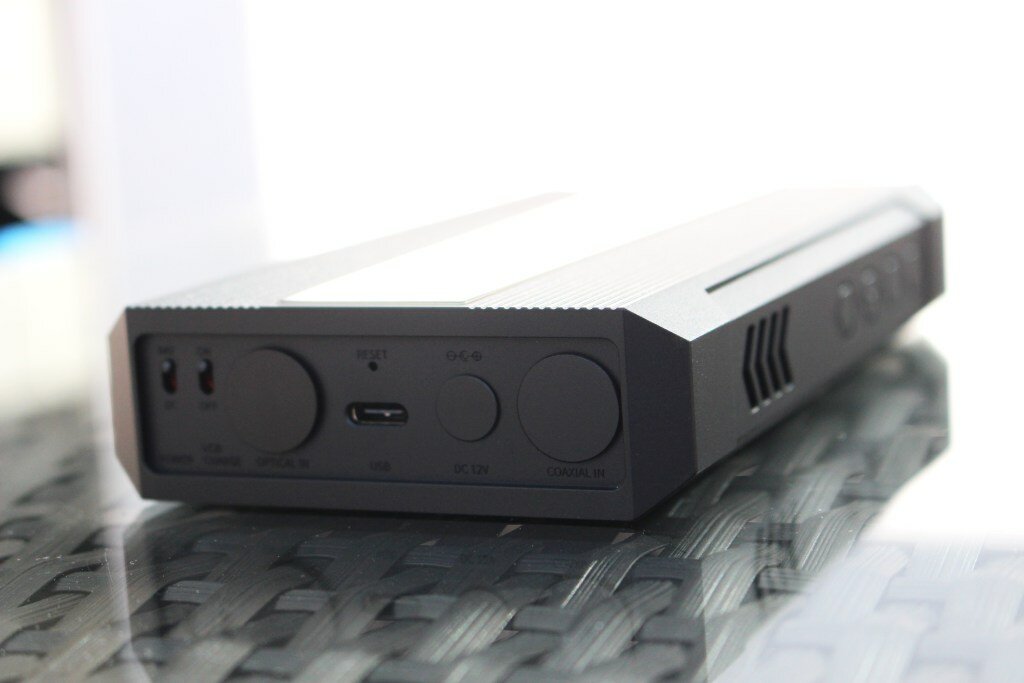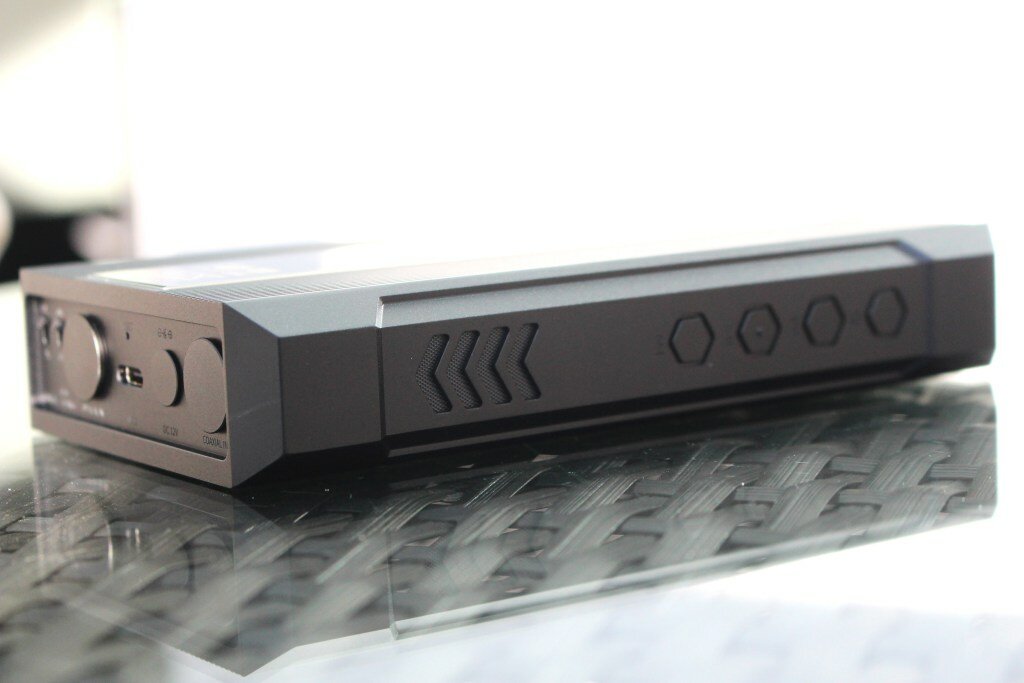With the highly anticipated release of the Fiio Q7, the device represents the flagship of the “Q” Series with components mirroring the flagship M17 Digital Audio Player. For top-quality performance, the Q7 comes fully equipped with Dual THX AA788+ Amp circuits, flagship-grade ES9038 Pro Sabre DAC and Qualcomm’s QCC5124 Bluetooth receiver.
Fiio have always been hailed as the ‘value-for-money’ king in the audio scene. Of late, they have positioned themselves in the premium hi-fi market reflecting the choice of high quality components and high-fidelity sound. While some may not consider it a bargain, the Fiio Q7 retails for a considerable $799 representing a sizeable investment.
Like the Fiio M17 shortly before it, the Fiio Q7 fits into the ‘transportable’ category of devices with its relatively hefty weight – allowing to be used as a portable desktop-class balanced headphone amplifier and DAC. The design philosophy is also shared with the M17 Digital Audio Player with strong angular emphasis and an ‘alienware’ feel.

The Packaging
The Fiio Q7 comes in a rather large box akin to the M17 before it. The Q7 is housed in a foam insert with a tanned leatherette case (which is slightly different to the darker version that comes with the M17). The leatherette case provides necessary grip and has undergone a rehaul to fit the Fiio Q7 before it.
Other accessory items include a USB power cable, a USB adapter, a Type C – Type C data cable, a quick-start guide, a multi-function dock and external switching mode power supply.
Overall, the packaging of the Fiio Q7 heralds that of a premium product given its substantial size and heft.

The Design & Build
The Fiio Q7 shares its design philosophy with the Fiio M17 – the real difference is that the Q7 does not share the same IPS Screen as the M17 Digital Audio Player before it.
The device is constructed from a solid CNC machined aluminum chassis with a ribbed and glass panel finish. At the top of the device, there is a well-constructed golden potentiometer with a textured design allowing an easy tactile rotation. Besides this, the I/O include a LO and PO analog out in both single-ended and balanced variants. This allows users to connect with a variety of in-ear monitors including 3.5mm and 6.35mm SE as well as the 2.5mm/4.4mm from balanced outputs.
At the bottom of the device, the Fiio Q7 contains two dial switches allowing users to move between battery and DC mode as well as switching the device to charge via USB on and off. At the center, there is a single USB port allowing charging and data transfer as well as digital OTG/DAC services form the same port. Unfortunately, there is no local memory storage options. Also included are optical and coaxial inputs.
At the right of the device, Fiio have opted for hexagonal tactile buttons including a power on/off alongside fast forward, fast backward and play/pause buttons.

The Internals
The Fiio Q7 employs a dual THX AAA 788+ amplifier set up – this is the same set up as the M17 Digital Audio Player as well as the full desktop K9 PRO ESS.
Users are able to achieve multiple levels of power output between both single-ended and balanced mode. The Q7 uses a single ES9038PRO chipset 4-channel implementation which is combined with an XU316 USB stage for digital decoding – this is contrast to the M17’s dual ES9038PRO and an XMOS XUF208 set-up.
There is a dual clocking design with dual DK femtosecond crystal oscillators which target both 44.1 kHz and 48 kHz frequencies. The Q7 is still able to handle both native DSD512 and PCM up to 32 Bit/768 kHz (USB-DAC mode). In addition, the Q7 will handle MQA unfolding up to 8x and a maximum of 384 kHZ.
In terms of wireless capabilities, the Fiio Q7 is able to support all the latest codecs of the Bluetooth thanks to a Qualcomm QCC5134 chipset.

The Battery
As expected from a hefty device, the Fiio Q7 comes packed with a gargantuan 9200 mAh li-poly battery giving a total of around 10 hours playback form single-ended connection and 8-9 hours from balanced. For reference this places it higher in mAh than the Fiio M15’s 7490 mAH battery as well the Cayin N8’s 7000 mAh and LPGT’s 5500 mAH. The Fiio Q7 roughly takes 4.5 hours to charge – there is possibility to charge and playback at the same time using the DC power mode (which is a much needed and convenient option).
Sound Quality
The Fiio Q7 is an extremely capable portable amp and DAC with the audacity of its desktop counterpart while being easily transported across the house.
Despite the single ES9038PRO chipset compared to the M17’s dual combo implementation, the Fiio Q7 is highly dynamic sounding with great predilection for micro-detail retrieval, nuance and depth. The Q7 is a quality device with ultra-low distortion levels as evidenced by its pitch-black background and jitter-free performance.
While the Fiio Q7 neither leans towards a bright or dark performance, it is a very dynamic sound with a neutral to natural sound. There are differences with the DC mode on with the Fiio Q7 becoming holographic, immersive and grants more headstage.
Overall, the Fiio Q7 revels in an airy sound with plenty of low-end heft, some forward upper midrange presence and treble which is resolute with plenty of clarity and detailing up top. It is surprising to see the amount of the dynamic swing that the Q7 is able to offer with the ability to produce micro-dynamic swings at both low and high volumes.
The performance is largely linear with an accomplished sonic soundscape with a sense of space and separation. The Fiio Q7 is very punchy with a polished tonality that is open, layered as well as detailed. It is able to bring out a great performance from IEMs and headphones alike.
In terms of matchability, the Q7 is an extremely flexible device offering a wide range of outputs from single-ended 3.5mm TRS, 6.35mm alternative to 2.5mm TRRS and 4.4mm Pentaconn balanced alternatives. With its wide variety of output power, the Q7 is able to handle sensitive IEMs to demanding headphones.
The low noise performance is something to write home about with the Q7 offering the pitch-black background with great perfect channel matching.

Comparisons
Earmen Angel ($799)
Both the Earmen Angel and the Fiio Q7 are very similar devices – with even the same price. They both come in rectangular prism shapes with some heft taking each device into the ‘transportable’ category. In terms of sound fidelity, the Earmen Angel leans more towards a musical sound production with a touch more organic sounding timbre, while the Q7 leads in technicalities, transparency, overall sound fidelity and dynamism.
The Fiio Q7 caters to more sets of transducers with its plethora of input and output options but the Angel is certainly no slouch in this department. Overall, the technicalities are with the Fiio Q7 while the musicality factor is awarded to the Earmen Angel.
Cayin N8 ($3299)
While the Cayin N8 is not a dedicated portable DAC/Amp – it is a digital audio player that is also within the transportable/desktop part of the high-fidelity marketplace. Both the N8 and Fiio Q7 are very flexible devices capable of catering to a wide variety of in-ear monitors and headphones.
In terms of the sound signature, the N8 adopts a more rich sound with emphasis on a slightly softer tonality capturing both the harmonic distortion from tubes but also the depth, transparency and dynamism from its solid-state counterpart. Both devices are capable of outputting high amounts of power and are able to drive power-hungry headphones.
Conclusion
The Fiio Q7 is an incredibly well-accomplished DAC-Amp offering with its fantastic linear and detailed presentation. It is able to provide host to a wide variety of in-ear monitors and headphones owing to its range of input/output options and gain levels. Overall, the Fiio Q7 is an extremely well thought out offering that is priced to compete with other desktop offerings. Yes, it is not going to have the same screen as options for streaming options as its counterpart digital audio player – Fiio M17 – but it is designed to be a versatile DAC-Amp capable of bringing the best out of various audio transducers.
The pricing still represents good value for money and certainly the Fiio Q7 will be heralded as a must-try out for a Dac-Amp combo under the $1000 range.
